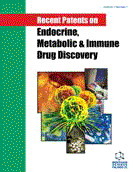Abstract
Omega-3 fatty acids except for their effect on triglycerides levels have cardioprotective properties as well as antiarrhythmic properties.The pleiotropic effects of omega-3 fatty acids, also, include lowering of blood pressure and the favorable effect on endothelial function and high-density cholesterol levels. Furthermore, studies have showed their favorable action in subjects with dementia, Alzheimers disease and learning disorders. In this paper, a review of the recent patents on omega-3 fatty acids will be presented.
Keywords: Arrhythmia, blood pressure, cancer, dementia, omega-3 fatty acids, pleiotropic effects, triglycerides, hypertriglyceridemia, LDL-cholesterol
Recent Patents on Endocrine, Metabolic & Immune Drug Discovery (Discontinued)
Title: Pleiotropic Effects of Omega-3 Fatty Acids
Volume: 6 Issue: 1
Author(s): Athanasia K. Papazafiropoulou, Marina S. Kardara and Stavros I. Pappas
Affiliation:
Keywords: Arrhythmia, blood pressure, cancer, dementia, omega-3 fatty acids, pleiotropic effects, triglycerides, hypertriglyceridemia, LDL-cholesterol
Abstract: Omega-3 fatty acids except for their effect on triglycerides levels have cardioprotective properties as well as antiarrhythmic properties.The pleiotropic effects of omega-3 fatty acids, also, include lowering of blood pressure and the favorable effect on endothelial function and high-density cholesterol levels. Furthermore, studies have showed their favorable action in subjects with dementia, Alzheimers disease and learning disorders. In this paper, a review of the recent patents on omega-3 fatty acids will be presented.
Export Options
About this article
Cite this article as:
K. Papazafiropoulou Athanasia, S. Kardara Marina and I. Pappas Stavros, Pleiotropic Effects of Omega-3 Fatty Acids, Recent Patents on Endocrine, Metabolic & Immune Drug Discovery (Discontinued) 2012; 6 (1) . https://dx.doi.org/10.2174/187221412799015254
| DOI https://dx.doi.org/10.2174/187221412799015254 |
Print ISSN 1872-2148 |
| Publisher Name Bentham Science Publisher |
Online ISSN 2212-3334 |
 26
26Related Articles
-
Folate-modified Graphene Oxide as the Drug Delivery System to Load Temozolomide
Current Pharmaceutical Biotechnology 5-Hydroxymethylfurfural (HMF) in Organic Synthesis: A Review of its Recent Applications Towards Fine Chemicals
Current Organic Synthesis Cardiovascular Risk, Inflammation and Physical Activity in Rheumatoid Arthritis
Current Rheumatology Reviews Targeting Kinin Receptors for the Treatment of Neurological Diseases
Current Pharmaceutical Design Daidzein and its Effects on Brain
Current Medicinal Chemistry A Decrease in the Cellular Phosphodiester to Phosphomonoester Lipid Ratio is Characteristic of HIV-1 Infection
Current HIV Research Modulators of Acetylcholinesterase Activity: From Alzheimer's Disease to Anti-Cancer Drugs
Current Medicinal Chemistry Fish Oil Prevents Oxidative Stress and Exerts Sustained Antiamnesic Effect After Global Cerebral Ischemia
CNS & Neurological Disorders - Drug Targets Common Variants in Toll-Like Receptor 4 Confer Susceptibility to Alzheimer’s Disease in a Han Chinese Population
Current Alzheimer Research The Role of Peptidyl Prolyl Isomerases in Aging and Vascular Diseases
Current Molecular Pharmacology Recent Studies on Design and Development of Drugs Against Alzheimer’s Disease (AD) Based on Inhibition of BACE-1 and Other AD-causative Agents
Current Topics in Medicinal Chemistry Serotonin 5-HT<sub>1A</sub> Receptors and Antipsychotics - An Update in Light of New Concepts and Drugs
Current Pharmaceutical Design The Many Neuroprogressive Actions of Tryptophan Catabolites (TRYCATs) that may be Associated with the Pathophysiology of Neuro-Immune Disorders
Current Pharmaceutical Design Molecular Effects of L-dopa Therapy in Parkinson’s Disease
Current Genomics Folic Acid Can Contribute to Memory Deficit and Na+, K+- ATPase Failure in the Hippocampus of Adolescent Rats Submitted to Hypoxia- Ischemia
CNS & Neurological Disorders - Drug Targets Radiopharmaceutical: Revolutionary Agents for Diagnosis
Current Radiopharmaceuticals “Vascular Incontinence” and Normal-Pressure Hydrocephalus: Two Commonsources of Elderly Incontinence with Brain Etiologies
Current Drug Therapy Fibrinogen Signal Transduction as a Mediator and Therapeutic Target in Inflammation:Lessons from Multiple Sclerosis
Current Medicinal Chemistry Everyday Cognition Scale Items that Best Discriminate Between and Predict Progression From Clinically Normal to Mild Cognitive Impairment
Current Alzheimer Research Polyphenols: A Diverse Class of Multi-Target Anti-HIV-1 Agents
Current Drug Metabolism






















